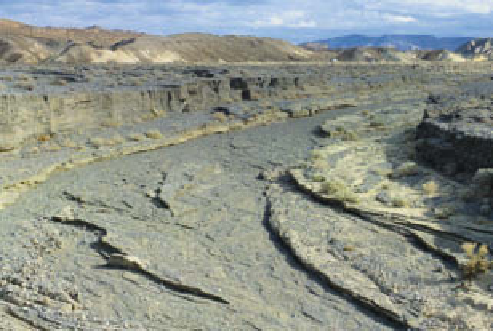Geoscience Reference
In-Depth Information
Braided channels
Low flows divide into separate streams around central
bars, whilst at higher flows central bars are dissected and
point bars cut off by the development of an inside
chute
.
The bars are normally resubmerged and single-channel
flow is restored at mean flow levels, but for a time the
channel was braided. Persistent braiding represents un-
stable channel conditions. It usually occurs in steep rivers
experiencing high discharge and carrying large-calibre
high sediment loads and in glacial or arid environ-
ments subject to rapidly changing water and sediment
discharges. More stable, high-discharge mountain chan-
nels braid on entering the piedmont zone (
Plate 14.17
).
In effect, river flow is overloaded with bed load beyond
the competence of all but the highest discharges. Large
sediment volumes are dumped as soon as discharge or
channel slope falls significantly. This drastically increases
channel roughness, giving the highest Reynolds number.
produced as a result of reworking of a large debris fan by
ephemeral stream flow in Furnace Creek Wash, Death Valley,
south-east California.
Photo: Ken Addison
River terraces, climate and tectonics
APPLICATIONS
Floodplain development may be a product of fluvial processes alone. However, erosion, aggradation and
terrace
formation are also responses to wider environmental changes. Changing climate, vegetation and land use lead to
changes in catchment water and sediment fluxes, and base-level changes alter catchment energy balances. They
are particularly common during the restless changes of the Quaternary period, with linkages between glaciation, sea
level, active tectonics, climate and catchment character now altering our whole perception of fluvial responses.
Terraces may be cut in bedrock to form valley-side berms, or represent the remnant sediments of previous floodplain
surfaces. Unpaired terraces are likely to reflect gradual denudation-driven incision as the river meanders across its
flood plain, or tectonic uplift on the terraced side of an axial (structure-parallel) river. By comparison, paired terraces
were formerly attributed to significant downcutting adjusting to falling sea levels (
thalassostatic
terraces).
Figure
14.29
summarizes the geomorphic impact of uplift and subsidence in a physical model using a flume - a laboratory
scale model of a floodplain section, complete with suitably scaled sediment and stream flow (after Ouichi 1985).
Distances are in metres in the flume, measuring 9 m long 2.4 m wide 0.6 m deep.
Base-level changes are driven by tectonic activity and/or eustatic change in sea level, with glacio-isostasy and glacio-
eustasy important during the Quaternary. Buried channels in flood plains may indicate earlier incision during lower
(cold stage) sea levels. Crustal deformation (through tectonic or isostatic uplift) is likely to tilt or warp terraces over
time, evident from terrace convergence/divergence or deformation respectively. There is some evidence of this in
the Thames terraces
(
Figure 14.30a
)
and it probably reflects complex glacio- isostatic/eustatic adjustments in North
Sea base levels. Terrace aggradation is essentially driven by climate change, with increased sediment flux from upper
catchments fuelling downstream aggradation. Aggradation can therefore accompany fallingsea levels as well as rising
sea levels. Much past climate and environmental information is now derived from detailed palaeontological and
stratigraphic analysis of terrace sediments. This is important in its own right but also because, from early prehistory
(after 0·9 Ma), European hominids chose flood plains as occupation and hunting sites. Their trace helps to date and
correlate Britain's flood plains. Terraces in middle sections of England's three main lowland rivers, the Thames, Trent
and Severn, possess terraces formed during the past three, two and one temperate (interglacial) stages respectively
(
Figure 14.30
).
Cut-and-fill structures also reveal components attributable to intervening cold stages on the basis of
incorporated biogenic material and human artefacts. The proxy record of fluvial responses to past climate-driven
environmental change informs watershed models working to predict the catchment impacts of current climatic trends.









































